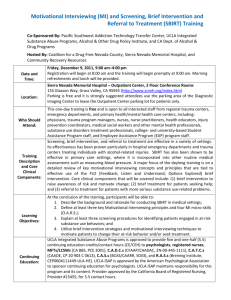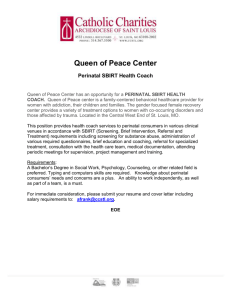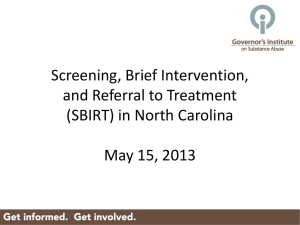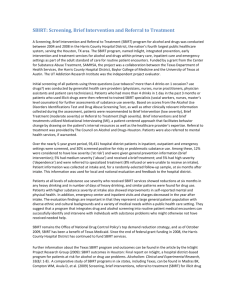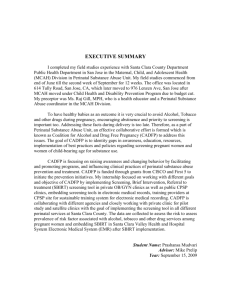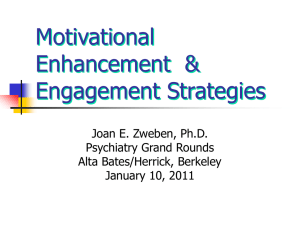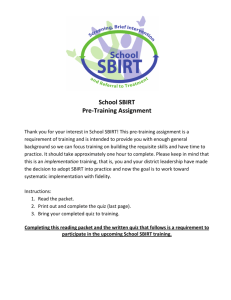Effecting Change through the Use of Motivational Interviewing
advertisement
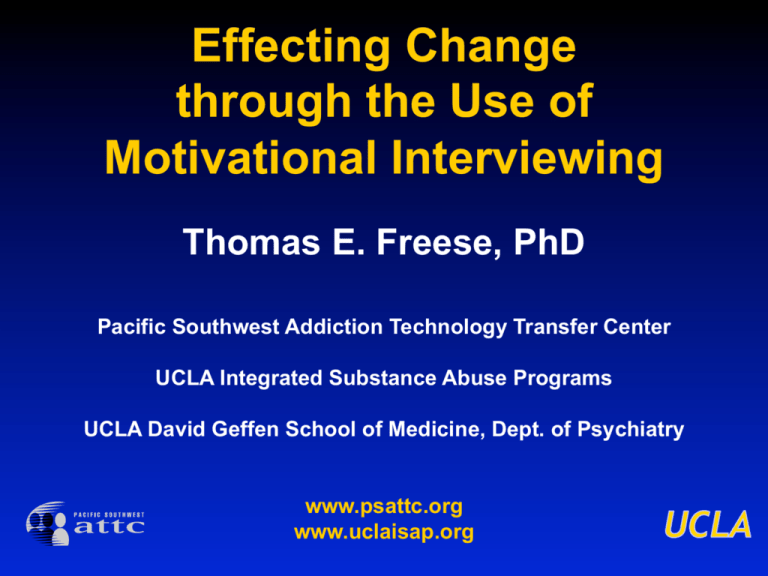
Effecting Change through the Use of Motivational Interviewing Thomas E. Freese, PhD Pacific Southwest Addiction Technology Transfer Center UCLA Integrated Substance Abuse Programs UCLA David Geffen School of Medicine, Dept. of Psychiatry www.psattc.org www.uclaisap.org Has anyone seen my motivation? What is Motivation? I think I lost it somewhere between here and who cares! Traditional approach Motivating for change UNDERSTANDING HOW PEOPLE CHANGE: MODELS Directing Style of Helping • • • • • • • • Tell them it’s important Show them how to do it Explain it to them, how life could be better Threaten them, instill fear Give them short term goals Make them a list Constantly remind them Tell them what you expect A Different Approach: The Guiding Style Guiding Style of Helping • • • • • Respect their decisions Have them to describe what is working Ask them about their plan Find out what’s important to them Have them talk about their health and their goals • Ask what their goals are for treatment Guiding Style of Helping • Motivational Interviewing can be considered a specialized subset of a Guiding style. • How does MI work to facilitate change? – Reduces resistance – Raises discrepancy – Elicits change talk What is Motivational Interviewing? Developed by William Miller (U New Mexico), Stephen Rollnick (Cardiff University School of Medicine), and colleagues over the past three decades. Miller and Rollnick (2012, p. 29) define MI as: “a collaboraNve, goal-­‐oriented style of communicaNon with parNcular aPenNon to the language of change. It is designed to strengthen personal moNvaNon for and commitment to a specific goal by eliciNng and exploring the person’s own reasons for change within an atmosphere of acceptance and compassion.” Everyone is doing it! In Combination with Other EBT Mental Health Couples Treatment Parents and Families Eating Disorders Adolescents/Young Adults Medication Adherence Criminal Justice/Probation HIV-risk Behaviors Treatment Engagement and Retention Diet & Exercise (diabetic, hypertension) Dual Diagnosis (psychosis, depression, anxiety) Alcohol/Drug (cannabis, cocaine, heroin, nicotine) Data on MI for SUD and Other Behaviors: A meta analysis of 30 studies 0.7 Effect Size 0.6 0.5 0.4 0.3 0.2 0.1 0 Alcohol (BAC Smoking Cessation Drug Addiction HIV-Risk Behavior Diet and Exercise Problem Area Burke, B.L., Arkowitz, H., & Menchola, M. (2003). Journal of Consulting MI in Medical Care Settings: A Meta analysis of 48 studies with 9,681 participants • Overall a moderate advantage over – Waitlist (7 studies) – Information only (16 studies) – Treatment as usual (28 studies) • MI most promising for: – HIV viral load – dental outcomes – death rate – body weight – alcohol and tobacco use – sedentary behavior, – self-monitoring – confidence in change • MI less effective for: – eating disorder – self-care behaviors – some medical outcomes (e.g., heart rate) Lundahl BW, et al., (2010). Research on Social Work Practice, 20, 137-160. The Underlying Spirit of MI Partnership Compassion MI Spirit Evocation Acceptance Four Processes of MI Planning Evoking Focusing Engaging Can it be MI without . . . • Engaging? • Focusing? • Evoking? • Planning? NO NO NO YES Roadblocks to Communication Roadblocks to Communication - Ordering, directing - Excessive reassuring, - Warning or threatening sympathizing, consoling - Giving advice - Questioning or probing - Persuading, arguing, excessively lecturing - Withdrawing, - Moralizing, preaching, telling distracting, humoring clients what they “should” do - Cultural/Racial - Disagreeing, judging, roadblocks blaming - Organizational - Praising prematurely or in roadblocks excess - Shaming, ridiculing, labeling - Gender/Age roadblocks Engagement: Beware of Traps! • Assessment Trap – If I just ask enough questions, I’ll know what to tell the client to do • Premature Focus Trap – Your idea of the problem and the client’s idea is different • Expert Trap – I’m in control and I have the answer Engagement: More Traps! • Labeling Trap – “You’re an alcoholic.” “You have a drug problem.” “You’re an addict.” • Blaming Trap – Who’s a fault for the problem? Who is to blame? • Chat Trap – Small talk without direction to the conversation The Concept of Ambivalence • Ambivalence is normal • Clients usually enter treatment with fluctuating and conflicting motivations • They “want to change and don’t want to change” • “Working with ambivalence is working with the heart of the problem” “People are better persuaded by the reasons they themselves discovered than those that come into the minds of others” Blaise Pascal The Interview Summarize and Ask Key Question Plan Evoke Focus Engage Core Skills • • • • O pen-Ended Questions A ffirmations R eflective Listening S ummarizing Open-Ended Questions § Are difficult to answer with brief replies or simple “yes” or “no” answers. § Contain an element of surprise; you don’t really know what the patient will say. § Are conversational door-openers that encourage the patient to talk. § Is this an open-ended or closed-ended question? Open and Closed Questions Quiz 1. Don’t you think your drinking is part of the problem? C 2. Tell me about when you were able to quit smoking? O 3. How is it going with managing your pain meds? O 4. Do you know you might die if you don’t stop using? C 5. What do you want to do about your drinking? O 6. Can you tell me about what you know about your heart condition? C Converting Closed Questions 1. Do you think your drug use is a problem? 2. Do you have any health problems related to your drinking? 3. Have you considered getting some professional help? 4. Are you worried about dying? 5. Would there be any benefits to not smoking marijuana? The Communication Cycle 1. What the client means. 2. What the client actually says. Accurate Empathy 1=4 4. What the clinician says he or she heard. 3. What the clinician hears. Levels of Reflection Simple Exactly repeating one or more aspects of what is said or changing one or more of the words used in a statement (no meaning is added) Complex Reflecting the inferred meaning of a statement or paraphrasing that focuses on the emotional aspect of the statement (meaning is added on to what was said) Reflective Listening Making your best guess about what a paNent means. What does the client mean? I should stop using it. Tell me about your marijuana use. What does this client mean? I know I shouldn’t have. He just came by and I couldn’t turn him away. What made you decide to see him? What does the patient mean? What about it? What difference does it make? How are things going with the medication? Forming Reflective Statements If you find it helpful, start your reflections with the following: “It sounds like you…” “You’re feeling…” “It seems that you…” “So you…” What is the focus? Psychiatric Alcohol Use Illness Medical Issues Housing HIV Risk Drug Use Treatment Adherence Medication Adherence Agenda Mapping Alcohol Use Psychiatric Illness Treatment Adherence Medical Issues Drug Use HIV Risk Behavior MedicaNon Adherence Housing The MI Hill Pre-Contemplation Contemplation Preparation Action Recognizing Resistance Resistance is when patients : • argue • interrupt • fail to link (problems to use) • ignore problems • fail to engage or follow through Where does resistance start? Rolling with Resistance To reduce resistance: • Shift the focus • Reframe • Emphasize personal choice and control • Stop providing solutions • Talk about something else CONDUCTING A BRIEF INTERVENTION FLO: THE 3 TASKS OF A BI L O Feedback Listen & Understand Options Explored W Warn F Avoid Warnings! (that’s it) 4 HOW DOES IT ALL FIT TOGETHER? Feedback Se*ng the stage Tell screening results Explore pros & cons Listen & understand Explain importance Assess readiness to change Discuss change op>ons Op>ons explored Follow up THE 3 TASKS OF A BI F L O Feedback Listen & Understand Options Explored THE 1ST TASK: FEEDBACK The Feedback Sandwich Ask Permission Give Feedback Ask for Response THE 1ST TASK: FEEDBACK What you need to cover: 1. Range of scores and context 2. Substance use norms in population 3. Screening results 4. Interpretation of results (e.g., risk level) 5. Patient feedback about results THE 1ST TASK: FEEDBACK What do you say? 1. Range of score and context -­‐ Scores on the AUDIT range from 0-­‐40. 2. Norms – Most people who are social drinkers score less than 8. 3. Results -­‐ Your score was 18 on the alcohol screen. 4. InterpretaNon of results -­‐ 18 puts you in the moderate-­‐ to-­‐high risk range. At this level of use, you are at significant risk for having or developing a variety of health issues. 5. PaNent reacNon/feedback -­‐ What do you make of this? The 1st Task: Feedback Finding the conversation… • Ask the patient about their concerns • Provide non-judgmental feedback/information • Watch for signs of discomfort with status quo or interest or ability to change • Always ask this question: “What role, if any, do you think alcohol played in your (getting injured)? • Let the patient decide. • Just asking the question is helpful. SUD Medical Housing Family Mental Health SUD O L F Options Explored Feedback Listen & Understand 5 THE 2ND TASK: LISTEN & UNDERSTAND Tools for Change Talk • Pros and Cons • Importance/Readiness Ruler DIGGING FOR CHANGE: THE DECISIONAL BALANCE The good things about ______ The notso-good things about ____ The not-sogood things about changing The good things about changing Avoid questions that call for a yes/no answer. THE 2ND TASK: LISTEN & UNDERSTAND Listen for the Change Talk • Maybe drinking did play a role in what happened. • If I wasn’t drinking this would never have happened. • Using is not really much fun anymore. • I can’t afford to be in this mess again. • The last thing I want to do is hurt someone else. • I know I can quit because I’ve stopped before. Summarize, so they hear it twice! THE 2ND TASK: LISTEN & UNDERSTAND Weighing the Pros and Cons not so good good Summarize Both Pros and Cons “On the one hand you said.., and on the other you said….” THE 2ND TASK: LISTEN & UNDERSTAND Importance/Confidence/Readiness On a scale of 1–10… • How important is it for you to change your drinking? • How confident are you that you can change your drinking? • How ready are you to change your drinking? For each ask: • Why didn’t you give it a lower number? • What would it take to raise that number? 1 2 3 4 5 6 7 8 9 10 The Payoff for Asking the Questions… • These questions will lead to a working treatment plan – Stage of change – Benefits of use – Consequences of use – Willingness to work on these issues 5 O Listen & Understand Options Explored Feedback L F THE 3RD TASK: OPTIONS FOR CHANGE What now? • What do you think you will do? • What changes are you thinking about making? • What do you see as your options? • Where do we go from here? • What happens next? THE 3RD TASK: OPTIONS FOR CHANGE Offer a Menu of Options • Manage drinking/use (cut down to low-risk limits) • Eliminate your drinking/drug use (quit) • Never drink and drive (reduce harm) • Utterly nothing (no change) • Seek help (refer to treatment) THE 3RD TASK: OPTIONS FOR CHANGE • • • • • During MENUS, explore previous strengths, resources, and successes Have you stopped drinking/using drugs before? What personal strengths allowed you to do it? Who helped you and what did you do? Have you made other kinds of changes successfully in the past? How did you accomplish these things? THE 3RD TASK: OPTIONS FOR CHANGE Closing the Conversation (“SEW”) • Summarize patient’s views • What agreement was reached (especially the pro) • Encourage them to share their views (repeat it) ENCOURAGE FOLLOWUP VISITS At follow-up visit: • Inquire about use • Review goals and progress • Reinforce and motivate • Review tips for progress Referral to Treatment for Patients at Risk for Substance Dependence REFERRAL TO TREATMENT • Approximately 5% of patients screened will require referral to substance use evaluation and treatment. • A patient may be appropriate for referral when: • Assessment of the patient’s responses to the screening reveals serious medical, social, legal, or interpersonal consequences associated with their substance use. These high risk patients will receive a brief intervention followed by referral. “WARM HAND-OFF” APPROACH TO REFERRALS • Describe treatment options to patients based on available services • Develop relationships between health centers, who do screening, and local treatment centers • Facilitate hand-off by: • Calling to make appointment for patient/student • Providing directions and clinic hours to patient/student • Coordinating transportation when needed PRACTICE FLO – DIVE RIGHT IN! • Try screening and giving feedback only • After several practices with F add in L & O • Post your questions and share your experiences on The World of SBIRT blog 6 MEDI-CAL SBIRT IMPLEMENTATION REIMBURSEMENT The following SBIRT services are covered: 1. Screening • • • • • Must use a Medi-Cal approved screening instrument (AUDIT, AUDIT-C) Limited to one unit per recipient per year, by any provider working under an SBIRT-trained supervisor A prescreen or brief screen is not reimbursable Bill under HCPCS code H0049; $24 SBIRT may be provided on same date of service as other E/M procedures MEDI-CAL SBIRT IMPLEMENTATION REIMBURSEMENT 2. Brief intervention • May be provided on the same date of service as the screening, or on subsequent dates • Limited to three sessions per patient per year, provided by any SBIRT-trained provider • Sessions may be combined in 1 or 2 visits, or be administered at 3 separate visits • Bill under HCPCS code H0050; $48 MEDI-CAL SBIRT IMPLEMENTATION REIMBURSEMENT 3. Rural Health Clinics (RHCs) and Federally Qualified Health Centers (FQHCs): • SBIRT costs are included in the all-inclusive prospective payment systems (PPS) rate • SBIRT services that meet the definition of an FQHC/RHC visit, as defined in the Rural Health Clinics (RHCs) and Federally Qualified Health Centers (FQHCs) section of the Part 2 – Medi-Cal Billing and Policy manual, are billable SBIRT IMPLEMENTATION COMMERCIAL PAYERS • Commercial insurance plans currently not required to cover annual SBIRT screening but some do • As with most healthcare procedures, they may all eventually follow the CMS lead • Billed as: • CPT code 99408 (alcohol/other substance screening & brief intervention, 15-30 minutes) • CPT code 99409 (alcohol/other substance screening & brief intervention, > than 30 minutes) SBIRT IMPLEMENTATION MEDICARE • Medicare covers SBIRT provided in outpatient offices/ clinics when medically necessary • In other words, you can use with your Medicare pts • Annual screenings not currently mandated • May be provided by: • • • • • • Physician Clinical psychologist LCSW Nurse Practitioner (NP) Physician Assistant (PA) Clinical Nurse Specialist (CNS) SBIRT IMPLEMENTATION MEDICARE • Billed as: • HCPCS code G0396 (alcohol/other substance screening & brief intervention, 15-30 minutes) • HCPCS code G0397 (alcohol/other substance screening & brief intervention, > than 30 minutes • As of Jan 2013, SBIRT included within Telehealth Services STRATEGIES FOR IMPLEMENTATION • Study and Learn — Study the SBIRT models and guidelines — Consider how to apply best in your setting — Determine availability of behavioral health services for referral and treatment Source: Amy Brom, SBIRT presentation conducted at Northern CAIRS Provider Conference, August 7, 2012 STRATEGIES FOR IMPLEMENTATION • Decide — Choose the best screening method for you — Annually — What screening tool to use — Who will administer — Indications for screening (everyone, age groups, certain diagnoses) Source: Amy Brom, SBIRT presentation conducted at Northern CAIRS Provider Conference, August 7, 2012 STRATEGIES FOR IMPLEMENTATION • Prepare — Select a “champion” for the effort — Train clinicians and staff on their specific responsibilities — Put copies of screener, guidelines, etc. in exam rooms — Determine a record-keeping system (EHR’s?) Source: Amy Brom, SBIRT presentation conducted at Northern CAIRS Provider Conference, August 7, 2012 STRATEGIES FOR IMPLEMENTATION • Reinforce — Remind staff regularly — Collect success stories to encourage ongoing implementation/support — Accept feedback from staff and patients and adapt as you go Source: Amy Brom, SBIRT presentation conducted at Northern CAIRS Provider Conference, August 7, 2012 FOR ASSISTANCE ON IMPLEMENTATION SAMHSA TAP (Technical Assistance Publication Series) #33: Systems-Level Implementation of Screening, Brief Intervention, and Referral to Treatment (SBIRT) Available for download at: http://store.samhsa.gov/product/TAP-33-Systems-LevelImplementation-of-Screening-Brief-Intervention-andReferral-to-Treatment-SBIRT-/SMA13-4741 Excellent example of step-by-step SBIRT procedure: A Nurse-Delivered Brief Motivational Intervention for Women Who Screen Positive for Tobacco, Alcohol, or Drug Use Available for download at: http://www.mirecc.va.gov/apps/ activities/products/productDetail.asp? id=146 Useful Books Miller, W.R., & Rollnick, S. (2012). Motivational Interviewing: Helping People Change 3rd edition (New York, Guilford Press). Rollnick S., Miller, R. W., & Butler, C. C. (2008). Motivational Interviewing in Health Care: Helping Patients Change Behavior. Guilford Press, New York. Arkowitz, H., Westra, H. A., Miller, W. R., & Rollnick, S. (2008). Motivational Interviewing in the Treatment of Psychological Problems. Guilford Press, New York. Rosengren, D. B. (2009). Building Motivational Interviewing Skills: A Practitioner Workbook. Guilford Press, New York. Naar-King, S., & Suarez, M. (2011). Motivational Interviewing with Adolescents and Young Adults. Guilford Press, New York. Wagner, C., & Ingersoll, K. (2013). Motivational Interviewing in Groups. New York: Guilford Press. Useful References Burke, B.L., Arkowitz, H., & Menchola, M. (2003). The efficacy motivational interviewing: A meta-analysis of controlled trials. Journal of Consulting and Clinical Psychology, 71, 843-861. Hettema, J., Steele, J., & Miller, W.R. (2005). Motivational interviewing. Annual Reviews of Clinical Psychology, 1, 91-111. Miller, W.R., & Rose, G.S. (2009). Toward a theory of motivational interviewing. American Psychologist, 64, 527-537. Lundahl BW, Kunz C, Brownell C., Tollefson D, and Burke B. (2010). Meta-analysis of motivational interviewing: Twenty Five years of empirical studies. Research on Social Work Practice, 20, 137-160. Smedslund, G., Berg, R.C., Hammerstrom, K.T., Steiro, A., Leiknes, K.A., Dahl, H.M., & Karlsen, K. (2011). Motivational interviewing for substance abuse. Cochrane Database of Systematic Reviews, Issue 5. Art. No.: CD008603. Useful Websites • www.motivationalinterviewing.org • www.casaa.unm.edu • www.guilford.com/p/miller2 THANK YOU!! Thomas E Freese, PhD tfreese@mednet.ucla.edu For additional information on this or other training topics, visit: www.psattc.org www.uclaisap.org/dmhcod
